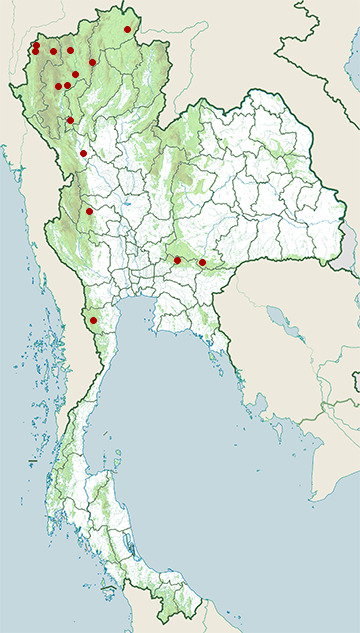Species of Thailand
White-rumped falcon
Polihierax insignis
Arthur Hay, A.K.A. Viscount Walden, 1872
In Thai: เหยี่ยวเล็กตะโพกขาว
The white-rumped falcon (Polihierax insignis) is a species of bird of prey in the family Falconidae native to Indochina. It is sometimes placed in its own monotypic genus, Neohierax.
Taxonomy and naming
Philip Sclater, secretary of the Zoological Society of London, presented two skins at the meeting of 7 November 1871, on behalf of the society's president Arthur Hay, Viscount Walden. A brief account of this presentation was published in 1872, becoming the first formal description of the species.
In 1922, Harry Kirke Swann proposed a new monotypic genus for this bird, Neohierax. During the 20th century, most taxonomic authorities retained it in Polyhierax, though Brown and Amadon supported separating the two genera. Phylogenetic analyses of morphological characteristics found the white-rumped falcon to be basal to the Falco clade, but separate from the clade containing the pygmy falcon (or African pigmy falcon, Polihierax semitorquatus) and Microhierax (falconets or pigmy falcons).
Research in molecular genetics has also found that the white-rumped falcon is more closely related to the Falco falcons than it is to the pygmy falcon, and indicates two major clades within the extant members of the falcon subfamily, Falconinae. Boyd places the Microhierax falconets with the pygmy falcon in tribe Polihieracini, and the white-rumped falcon as Neohierax insignis in tribe Falconini.
The white-rumped falcon is also known as white-rumped pygmy falcon, white-rumped falconet, Fielden's falconet, or Burmese pigmy falcon.
Description
The plumage is white underneath and on the rump, with black ticking on the chest. The upper surface of the wings is dark grey. Sexually dimorphic, the female has a rufous mantle on her upper back and behind the head, whereas in the male these areas are grey. The tail is black, barred with white.
The shape of the tail is notably rounded, with the outermost feathers an inch shorter than the middle ones. Its wings have the pointed shape typical of falcons, with the second primary feathers longest, and the first nearly equal to the third.
Its legs and feet are yellow, hence the French name (yellow-legged falconet). Base of the bill and skin surrounding the eye are yellow. Tip of the beak is grey or horn-coloured.
The wings are 145 mm frac=4 long, and the tail is 130 mm frac=4. Modern sources give the overall length as 23 – 28 cm frac=4, weight 84 – 112 g, and wingspan 42 – 49 cm frac=4.
Its coloration is similar to the African pygmy falcon (Polihierax semitorquatus), but the white-rumped falcon is larger and proportionally longer-tailed.
Distribution and habitat
Found in Cambodia, Laos, Myanmar, Thailand, and Vietnam, its natural habitats are subtropical or tropical dry forests and dry savanna. The IUCN considers it "near-threatened" by habitat loss due to logging and forest fires, and possibly hunting.
Feeding
White-rumped falcons feed on lizards and insects, which are taken from the ground or in trees. Unlike Microhierax falconets, they do not hawk insects from the air.
Breeding
This species has been little studied in the wild. It uses holes in trees for nesting, the female incubates the eggs during the day. The female lays a clutch of two white eggs, approximately 35 mm long.
A pair have been observed to nest in a woodpecker hole, both the male and female roosting there overnight.
This article uses material from Wikipedia released under the Creative Commons Attribution-Share-Alike Licence 3.0. Eventual photos shown in this page may or may not be from Wikipedia, please see the license details for photos in photo by-lines.
Category / Seasonal Status
BCST Category: Recorded in an apparently wild state within the last 50 years
BCST Seasonal status: Resident or presumed resident
Scientific classification
- Kingdom
- Animalia
- Phylum
- Chordata
- Class
- Aves
- Order
- Falconiformes
- Family
- Falconidae
- Genus
- Polihierax
- Species
- Polihierax insignis
Common names
- Thai: เหยี่ยวเล็กตะโพกขาว
Synonyms
- Neohierax insignis
Conservation status

Near Threatened (IUCN3.1)

Near Threatened (BirdLife)

Vulnerable (ONEP)

Vulnerable (BCST)
Photos

Range Map

- Chiang Dao Wildlife Sanctuary
- Doi Inthanon National Park
- Doi Lo District, Chiang Mai
- Huai Kha Khaeng Wildlife Sanctuary
- Kaeng Krachan National Park
- Khao Yai National Park
- Khun Chae National Park
- Khun Tan District, Chiang Rai
- Mae Ping National Park
- Mueang Chiang Mai District, Chiang Mai
- Mueang Tak District, Tak
- Namtok Mae Surin National Park
- Pai District, Mae Hong Son
- Tham Pla - Namtok Pha Suea National Park
- Thap Lan National Park